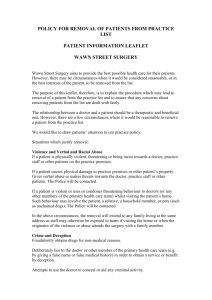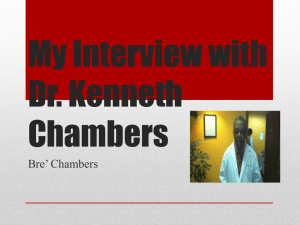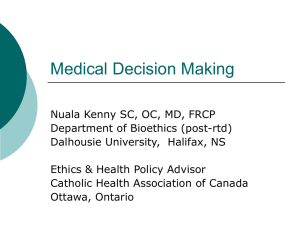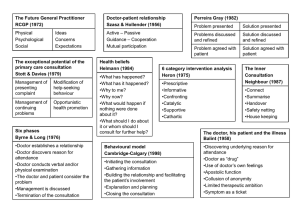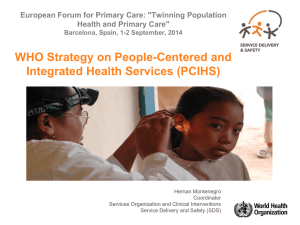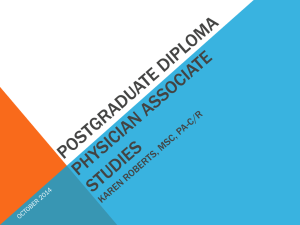A) Core communication skills
advertisement
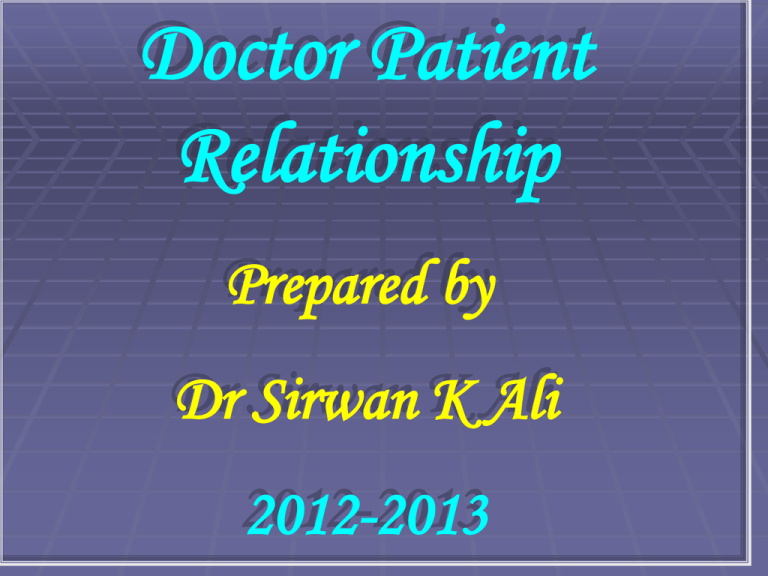
Doctor Patient Relationship Prepared by Dr Sirwan K Ali 2012-2013 Good physician treats the disease; the great physician treats the patient who has the disease ~ William Osler (Canadian Physician, 1849-1919) Content of the lecture: •Introduction •Parson ideal patient and doctor •What do patients want from a doctor •Styles of Dr-patient relationship •Communication skill •Conclusion The Doctor-Patient Relationship At the core of the practice of medicine The patient expects a good relationship as much as a cure Dr-patient relationship itself becomes part of the therapeutic process Introduction These two people have just met, but within seconds one has begun to tell the other intimate personal details about his health. What is more, it is likely that, in a few minutes, he will be prepared to remove some of his clothes and submit to a physical examination. The interaction is shaped by their differing social roles and their different needs. Parsons’ “Ideal Patient” Permitted to: Give up some activities and responsibilities Regarded as being in need of care In Return : Must want to get better quickly Seek help from and cooperate with a doctor Parsons’ “ Ideal Doctor” Apply a high degree of skill and knowledge Act for the good of the patient Remain objective and emotionally detached What do patients want from a physician? Patients want to be able to trust the competence and efficacy of their caregivers. Patients want to be able to negotiate the health care system effectively and to be treated with dignity and respect. Patients want to understand how their sickness or treatment will affect their lives, and they often fear that their doctors are not telling them everything they want to know. Patients want to discuss the effect their illness will have on their family, friends, and finances. Patients worry about the future. Patients worry about and want to learn how to care for themselves away from the clinical setting. The four different styles of Dr/patient relations Paternalistic: The paternalistic approach is typified by a doctor centered style. It relies on closed questions designed to elicit yes or no answers. The doctor will tend to use a disease centered model and be focused on reaching a diagnosis, rather than the patients unique experience of illness. The Paternalistic Approach “If I’ve told you once I told you 1,000 times, stop smoking!!” Patient controlled consultation Consumeristic : Here the patient knows exactly what they want and forces the doctor into a patient centered approach “You’re paid to do what I tell you!!” Default : This is where the patient centered style fails. The doctor is trying to relinquish control but the patient is unwilling to accept it, The result is an impasse. Mutuality: The doctor uses open questions to encourage the patient to talk about his complaint. This approach relies on taking time to listen and trying to understand the patients . point of view Mutual Styles It’s serious isn’t it doctor? Factors which influence Dr-Patient Communication Patient-related factors Dr-related factors The interview setting Patient-related factors Physical symptoms Psychological factors Previous experience Current experience Dr-related factors Training in communication skills Self-confidence in ability to communicate Personality Physical factors Psychological factors The interview setting Privacy Comfortable surroundings An appropriate seating arrangement Importance of Effective Doctor-patient Communication 1. Accurate diagnosis. 2. Enhancing patient compliance to treatment plans. 3. Contributing to doctor clinical competence and self assurance. 4. Contributing to patient satisfaction. Importance of Effective Doctor-patient Communication 5. Contributing to cost and resource effectiveness by preventing unnecessary prescriptions for medication that are either wrongly prescribed or not properly used by patients. Physician need To Acquire A) Core communication skills: Doctor-patient interpersonal skills. Information gathering skills. Information giving skills. Physician need To Acquire B) Advanced communication skills: Skills for motivating patient adherence to treatment plans. Skills for specific situations. Core Communication Skills 1- Doctor-patient interpersonal skills: Creating an appropriate physical environment. Greeting others. Empathy. Showing respect and interest. Showing warmth and support. Using appropriate language. Developing a collaborative relationship. Closing the interview. Core Communication Skills 2- Information gathering skills: a) Using an appropriate balance of open to closed questions: * Open question: To achieve information. To allow patients the freedom of response. To establish an atmosphere of two-way communication. To assess the type and level of patient vocabulary. *Closed questions: To achieve specific information. To allow a limited choice of response. Core Communication Skills 2- Information gathering skills: b) Silence: To allow time for the patient to collect his thoughts. To assess levels of anxiety. Core Communication Skills 2- Information gathering skills: Clarifying the information given to the patient. Active listening: To show that the therapist is attending closely the patient. Sequencing of events. Directing the flow of information. Summarizing. Core Communication Skills 3. Information giving skills: They include: 1. Providing clear and simple information. 2. Using specific advice with concrete examples. 3. Pushing important things first. 4. Using repetition (restatement). Core Communication Skills 3. Information giving skills: 5. Summarizing. 6. Categorizing information to reduce complexity and aid recall. 7. Using tools such as diagrams, written instruction and technical aids to explain the information being given. 8. Checking patient understanding of what has been said. 9. Asking patients to repeat back what they had heard and understood. Summary An intigrated approach to information gathering. Seeking to identify physical psychological and social factors Is likely to produce a better outcome. Thank you…


